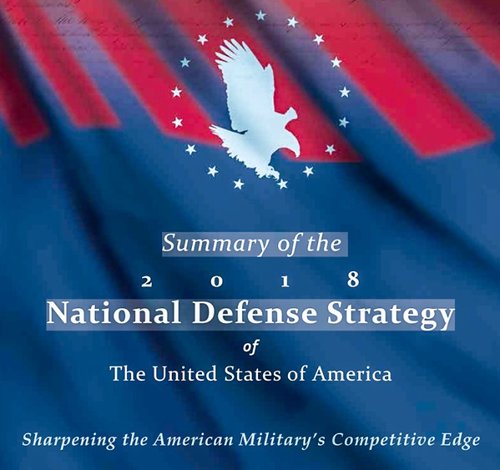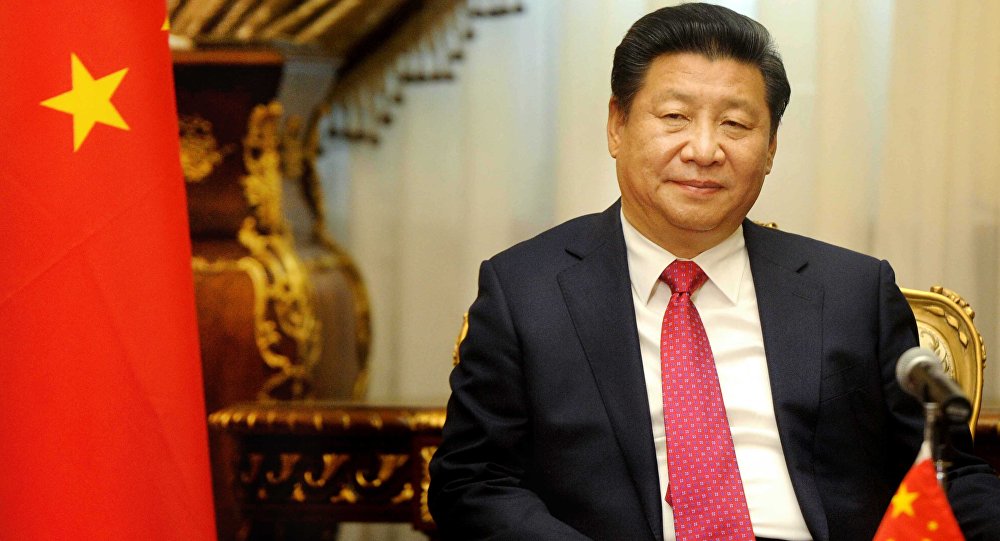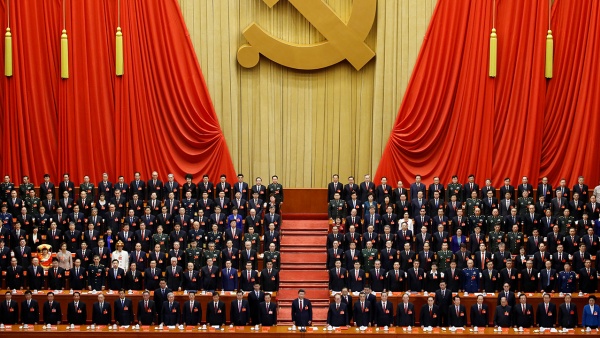By Elsa B. Kania
The U.S.-China relationship may shape the course of this century, and its future trajectory remains highly uncertain and contentious. Persistently, U.S. strategy has struggled to characterize and formulate a framework for America’s relationship with the People’s Republic of China (PRC). Today, as the U.S. and China dance on the precipice of a trade war, there is talk of a new Cold War in which the U.S. confronts a rival that is unique as not only a near-peer military competitor but also a rising economic and technological powerhouse. Increasingly, this competition is even extending into what has been characterized as “tech cold war” or an “artificial intelligence arms race.”[1,2] The status quo is seen as untenable by those who condemn the damages of years of “cyber-enabled economic warfare” and those who warn that our current course risks tumbling into Thucydides’ Trap.[3] Although high levels of cooperation and interdependence—particularly economic—between the U.S. and China could serve as a critical ballast for the relationship, such entanglement can just as readily constrain conflict as create frictions that render warfare more likely. Even as debates polarize, there is consensus that the stakes are high and the consequences of miscalculation would be historically deleterious.
2018 National Defense Strategy (OSD)
 American strategy is in the throes of a major course correction. The latest U.S. National Security and Defense Strategies have articulated a new focus on great power rivalry, characterizing China as a strategic competitor.[4] This new swing of the pendulum of history has repudiated prior hopes that “integration into the post-war international order would liberalize China.”[5] There have been fair and quite forceful critiques that prior administrations were at times too inclined to engage with and even accommodate the PRC in ways that have since proven injurious to U.S. interests[6]. The National Defense Strategy characterizes China as a revisionist power, assessing that it “seeks Indo-Pacific regional hegemony in the near-term and displacement of the United States to achieve global preeminence in the future.”[7] In response, the U.S. seeks to reorient towards a more forceful response to the attempts such of great power rivals “to shape a world antithetical to U.S. values and interests.”[8] The first challenge for U.S. strategy is to understand China and to recognize multifaceted challenges at the intersection of engagement and competition.
American strategy is in the throes of a major course correction. The latest U.S. National Security and Defense Strategies have articulated a new focus on great power rivalry, characterizing China as a strategic competitor.[4] This new swing of the pendulum of history has repudiated prior hopes that “integration into the post-war international order would liberalize China.”[5] There have been fair and quite forceful critiques that prior administrations were at times too inclined to engage with and even accommodate the PRC in ways that have since proven injurious to U.S. interests[6]. The National Defense Strategy characterizes China as a revisionist power, assessing that it “seeks Indo-Pacific regional hegemony in the near-term and displacement of the United States to achieve global preeminence in the future.”[7] In response, the U.S. seeks to reorient towards a more forceful response to the attempts such of great power rivals “to shape a world antithetical to U.S. values and interests.”[8] The first challenge for U.S. strategy is to understand China and to recognize multifaceted challenges at the intersection of engagement and competition.
CHINA’S QUEST
In recent history, China’s quest for national rejuvenation has arguably changed the world more than the world has changed the People’s Republic of China. The Chinese economy has achieved historic development, on track to overtake the U.S. as (or by some measures already) the world’s largest, yet has often contravened the rules on trade along the way.[9] Despite its embrace of certain features of capitalism, the Chinese Communist Party (CCP) remains committed to core features of its Marxist-Leninist and Maoist roots and ideology, along with the recent addition of “Xi Jinping Thought on Socialism with Chinese Characteristics for a New Era” to the constitution.[10] The Party itself has evolved and adapted to changing conditions, even incorporating a rising class of business leaders and entrepreneurs into its ranks.[11] Under Xi Jinping, the Chinese Communist Party has even been progressively devouring government institutions to achieve a closer fusion of party and state, as reflected in recent reforms that merge state and party institutions.[12] The Party has also exerted greater influence over a vibrant (so-called) private sector through greater presence within these enterprises.[13] The authoritarian influence of the Chinese Communist Party is also going global, provoking concerns worldwide over its use of sharp power in the tradition of political warfare, including united front and international liaison work activities which can have a corrosive impact on democracies.[14]

Xi Jinping (Ahmed Ohmar/AP)
At the same time, the Party’s grip on power has only tightened, with censorship, surveillance, and repression intensifying within China. These trends predate Xi Jinping’s leadership but have only accelerated since he came to power. It is clear the Chinese Communist Party is unwilling to tolerate any challenge to its state security (国家安全), that could jeopardize social stability or threaten the regime.[15] Consistently, activities that demonstrate the potential to galvanize collective action or mobilization against the regime—even the activism of feminists seeking to advance China’s #MeToo movement—are rapidly suppressed.[16,17] These issues are not only questions of human rights and fundamental freedoms, but rather are integral to understanding the nature of the current regime and its insecurities. Increasingly, these abuses of power extend beyond China’s borders, including a worldwide kidnapping campaign undertaken by the Party that may even have reached into the United States.[18] Meanwhile, the application of big data and artificial intelligence to social control can enhance the coercive capability of the Party-state, pioneering a new techno-authoritarian model that could diffuse and threaten democracy globally.
China’s rapid emergence as a powerhouse in science and technology has caused both anxiety and exuberance. Here too, the pendulum of perceptions is swinging—from seeing China only as a copycat to accepting the claims of techno-propaganda that it already does or inevitably will lead the world in innovation, when considerable challenges in fact, remain. Typically, the truth falls somewhere between extreme perspectives. China has achieved real and notable advances in innovation, though its progress in certain sectors has been enabled by both licit and illicit technology transfer, including extensive intellectual property theft.[19] Beijing’s ambitions to lead in original innovation in certain strategic emerging technologies, such as artificial intelligence (AI) and quantum information science, are striking and supported by new programs and extensive funding. At the same time, critical bottlenecks remain, ranging from the availability of top talent to failures in mastering semiconductors. China’s renewed scientific prowess may have a range of positive externalities, from clean energy to the use of artificial intelligence to enhance and personalize healthcare in precision medicine. However, there are also troubling indications that Beijing may seek to ensure that innovation made in China stays in China, by enacting new rules requiring that scientific data generated in China must be submitted to government data centers for approval prior to publication or dissemination.[20]

Xi Jinping stands before delegates at the closing session of the nineteenth National Congress of the Communist Party of China. (Thomas Peter/Reuters)
At the same time, China’s advances in dual-use technologies are priorities within a national strategy for military-civil fusion (军民融合). The Chinese People’s Liberation Army (PLA) is rapidly advancing military modernization at a time of intensifying nationalism that often borders on militarism. The Army, once dismissed as almost hopelessly backwards, has since emerged as a major contender and would-be peer competitor that is even challenging the U.S. in new frontiers of military innovation. Leaders of the Chinese Communist Party and the Peoples Liberation Army have long perceived the U.S. as the primary obstacle to their core priority of achieving reunification with Taiwan, and PLA writings often use the euphemism powerful adversary (强敌) in reference to the U.S. Evidently, the recent trajectory of Chinese defense development has focused on targeting perceived vulnerabilities in American ways of warfare, through the development of asymmetric capabilities, including for space, cyber, and electronic warfare. Given the scarcity and uncertain reliability of available information, major uncertainties remain regarding the Army's advances. The reports of advances in rail-guns, hypersonics, and even brainpower augmented by artificial intelligence for submarines should be taken skeptically but seriously.[21] At the same time, the Peoples Liberation Army struggles with a range of shortcomings, including in human capital and training, while remaining in the midst of a disruptive reform agenda intended to foster greater jointness.
Across all of these dimensions of competition U.S.-China rivalry is real and intensifying but there remain core issues about which there are strong incentives and imperatives for sustaining cooperation. The costs of a failure to cooperate are far too high to abandon attempts to advance such cooperation, even if the results may be mixed, as in the case of Beijing’s approach to the threat of North Korea. To dismiss engagement and cooperation as entirely failed strategies—despite the Chinese Communist Party's unsurprising resistance to liberalization—is too simplistic of a reading of the complexities of recent history. In the course of its rise the PRC has indeed become more of a status quo power in certain respects, undertaking constructive involvement on international issues and institutions, in approximate alignment with initial U.S. urging that it become a responsible stakeholder.[22] Even if Beijing’s commitment to certain challenges, such as climate change or peacekeeping missions, might be criticized as shallow or self-interested, there have still been some positive outcomes resulting from these activities.[23] With a greater stake in the status quo, China can be accurately characterized as a revisionist power on certain issues, or perhaps more aptly be called selectively revisionist.[24] The U.S. cannot change China’s core interests, but it can, in some cases, undertake targeted efforts to change PRC incentives and behavior, as on the threat of North Korea.
THE AMERICAN VIEW
To that end, the U.S. must recognize the limitations in its understanding of China and seek to interrogate frequent assumptions in pursuit of a more nuanced perspective on core questions. There are a number of known unknowns—and doubtlessly a number of unknown unknowns—that should catalyze a quest to advance deeper understanding of the PRC in order to recognize potential pressure points and opportunities for collaboration.
Take, for example, the state of elite politics in the PRC, at a time when China has become one of the most pivotal and powerful nations in the world. Is Xi Jinping’s apparent strength as a leader the result of high-level consensus or a fierce struggle for power within the Party? Has Xi already quashed all rivals and resistance, or has he made even more enemies and provoked intense inter-elite struggle that could be his undoing? The recent reforms to the constitution allow Xi to pursue further terms as state president, controlling the full trinity of roles as general secretary of the Chinese Communist Party, president of the PRC, and chairman of the Central Military Commission (CMC). This startling yet rather unsurprising development reflects further erosion of formal and informal institutions intended to ensure collective leadership to mitigate the repetition of Mao Zedong’s excesses.[25] Is Xi the man who commands China without challenge, or does he remain so insecure in his power that he cannot relinquish it without risking the derailing of his agenda?[26] Xi may very well be on a trajectory to rival Mao in his power—or perhaps, if Xi were truly in absolute control, he might choose to rule as merely chairman of China Soccer Association, in the tradition of Deng Xiaoping. With regard to Party-army relations, core questions remain similarly unanswered. How credible are rumors of a coup attempt against Xi Jinping? Will Xi’s historic military reforms be successful, or will the Army prove unable to overcome longstanding organizational pathologies? Our concerns over China’s strength should not result in a failure to examine potential weaknesses and brittleness in its system.
At the same time, the U.S. must also search for new paradigms of competition that return to core values and leverage enduring advantages—and that quest must start at home. The challenge of countering the long time horizons and whole-of-nation strategy of an authoritarian competitor is daunting, particularly at a time when faith in democracy is eroding precipitously.[27] Party propaganda asserting the superiority of their system over the dysfunctionality of democracies is most effective when it can simply draw upon realities. Certain elected leaders have even expressed envy of and admiration for their authoritarian counterparts.[28] It is deeply troubling, to say the least, that a recent study estimated that nearly three in ten Americans believe an authoritarian alternative to democracy would be favorable.[29] The indicators of U.S. vulnerability to democratic breakdown or backsliding, which predate recent political turbulence, should sound alarms that ring far beyond politics and partisanship.[30] Increasingly, the resurgence of racism and extremism, particularly from white nationalist groups, poses a major threat to U.S. homeland security.[31,32] There have been far darker moments in U.S. history, and American democracy has proven its resilience against division and disunity. Today, the U.S. must again forge ahead in advancing her “unfinished work” and seek a “new birth of freedom.”[33] This fight to renew and reinvigorate our democracy is a question of national security and competitiveness. The U.S. cannot compete with China’s national rejuvenation unless American can first achieve its own revitalization.
With the erosion of global order, it seems the center cannot hold, and mere anarchy may be loosed upon the world.[34] Will there be a second coming for American power and a new awakening for U.S. grand strategy?
...THE U.S. MUST BE CAREFUL NOT TO FALL INTO THE TRAP OF OVER-INVESTING IN THE MILITARY DIMENSION OF COMPETITION, LEST IT REPEAT THE MISTAKES OF THE SOVIET UNION IN THE COLD WAR.
Going forward, a nuanced approach to strategic competition with China should recognize that this is not merely a new Cold War, but rather a rivalry playing out in a much more chaotic and complex world, in which it is critical to sustain concurrent cooperation to counter mutual threats. Along the way, the U.S. must be careful not to fall into the trap of over-investing in the military dimension of competition, lest it repeat the mistakes of the Soviet Union in the Cold War. This is a period that PRC leaders have studied much more carefully than their victorious, and perhaps therefore too complacent, U.S. counterparts, and it would be ironic if the U.S. were to become the victim of its own techniques of competitive strategy. Instead, the U.S. must recognize that the center of gravity of its own power and of China’s rising strength is economics. China’s deft wielding of techniques of geoeconomics has enhanced its power and global influence—though its coercive approach to these tools may prove self-defeating—and the U.S. must look to enhance its own use of these instruments in ways consistent with its values and interests.[35]
ALTHOUGH U.S. OPENNESS CAN BE EXPLOITED, IT REMAINS, ON BALANCE, A TREMENDOUS ADVANTAGE IN A HIGHLY GLOBALIZED WORLD IN WHICH FLOWS OF TALENT, KNOWLEDGE, AND INFORMATION ARE FREE AND DYNAMIC.
America must recognize and leverage its true enduring advantages. The strength of U.S. alliances remains critical, but these must not be taken for granted at a time of new stresses and Beijing’s attempts to undermine them. The U.S. must expand economic and diplomatic engagement with partners old and new, especially in Asia. American soft power, currently in decline worldwide, must also be recovered and renewed as a counter to the sharpness of Chinese power.[36] This soft power flows from commitment to core values and the perfection of an imperfect democracy, which should be consistent objectives across U.S. domestic politics and diplomacy alike. Throughout its history, the U.S. has been a nation of immigration that attracts some of the best minds from across the world. America’s unfinished revolution of equality, diversity, and inclusivity must be continued—and should also be recognized pragmatically as a key competitive advantage in demography, not to mention a global ‘arms race’ for the talent critical to advance strategic innovation. China, too, is striving to recruit the world’s top talent, but its intensifying authoritarianism may repel many of its own citizens and others, despite the incentives and opportunities proffered. Although U.S. openness can be exploited, it remains, on balance, a tremendous advantage in a highly globalized world in which flows of talent, knowledge, and information are free and dynamic.
Looking to the future, the U.S. must not fear but rather should embrace a new era of competition. The best ways to compete in the 21st century involve the enhancement of the American education system and the embracing of the science and technologies key to the future. Beyond the dynamism of the U.S. private sector and innovation ecosystems, there is also an imperative of government funding for basic research and supporting infrastructure, such as greater investment in 5G technologies. In the process, certain regulations act as a major impediment to progress, while others are integral to sustain it and mitigate risk. The U.S. may be facing an innovator’s dilemma, but also possesses systemic advantages relative to China in the controlled chaos of managing innovation.[37,38] At worst, U.S.-China competition risks devastating miscalculations that could trigger trade or even kinetic war—but at best, this rivalry could be a critical catalyst for U.S. revitalization, and indeed rejuvenation, in a time of crisis and uncertainty.
Elsa B. Kania is a Featured Contributor on The Strategy Bridge and an Adjunct Fellow with the Technology and National Security Program at the Center for a New American Security, where she focuses on Chinese defense innovation in emerging technologies. She is the author of “Battlefield Singularity: Artificial Intelligence, Military Revolution, and China’s Future Military Power.”
This article appeared originally at Strategy Bridge.
No comments:
Post a Comment